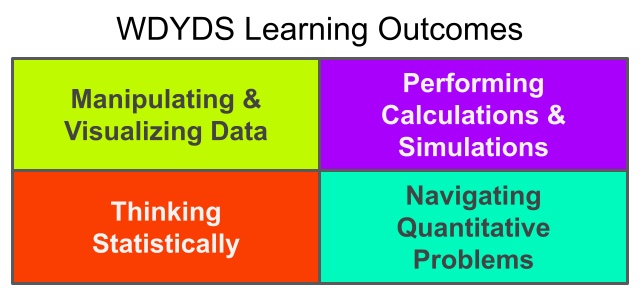Teaching
Contents
Teaching#
Teaching Statement#
I believe that a good teacher is more like an architect and navigator than an encyclopedia or public speaker. This means that when I prepare for courses, I spend much more time thinking about how the students will be learning, than what they will be learning.
While it is often useful for a teacher to be knowledgeable of specific content and to be able to communicate well, I find that a teacher can make maximal impact by having tools to help students mentally organize content, draw connections between different topics, and practice applying and recognizing concepts. This is because I believe that a teacher’s main role is to provide structures that facilitate students to develop new skills.
This philosophy can be seen most clearly in my course What Do Your Data Say? (WDYDS) which I had the joy of developing with Professor Madhav Mani during my time as a Ph.D. student. In this class, we aim to develop students as quantitative thinkers in the context of real biological data sets. This class started as a survey of important quantitative results in biology, but we found the results lacking - students were able to regurgitate facts about the papers and sometimes replicate analyses - but they didn’t always see how these concepts translated to their own data in their own research. This is a classic problem with transfer knowledge, but for us it reflected that we had not done enough to give students a structure into which they can put their new information.
In response, we redeveloped the course from top to bottom, making use of backwards course design to organize the material around four sets of learning goals. These learning goals consist of skills that we believe underpin success in performing modern quantitative data analysis. The idea is that by focusing on skills such as the ability to manipulate data into different formats or the ability to identify quantitative phenomena – which transcend any specific application in data science – we improve students’ abilities to actually perform quality data analysis on their own.

Using this framework, all course materials were redesigned so that they contribute to student progress towards these goals. For example, rather than using valuable class time lecturing, we pre-recorded the lectures and listed them as resources alongside the course notes on the class website. Instead, students’ class time was spent working on a variety of coding and math exercises either in groups or in a flipped classroom. This served both to allow students to actually practice data analysis skills, but also allowed us to teach via inquiry-based activities, which are generally considered to improve student outcomes in the classroom.
Beyond simply generating well-structured content, I also believe that it is a teacher’s role to help students navigate this content. This has two aspects: an explicitness in the course goals, and a commitment to practicing meta-cognition. The first idea is that now that we have these well-structured learning outcomes for the course, we can help students understand their own learning by explicitly indicating how all the parts of a course are connected to those goals. In WDYDS, this meant that all course materials were labeled with the (color-coded) learning goals that were being practiced in each individual worksheet, assignment, or lecture, which allows students to target their learning and make connections between different pieces of content. Furthermore, this perspective is also useful for the instructor, as it quickly indicates whether course materials and activities are working as intended, because student’s (lack of) success in executing the course goals can be directly linked to the various materials.
Similarly, I also believe that a teacher can further improve student outcomes by explicitly requiring students to practice meta-cognition in the classroom. In my experience, and in the literature, it has been noted that student achievement can often largely be explained by the quality of the “study skills” that students possess. In WDYDS, this is incorporated into the structure of the course by converting assignments into a 3 step process. First, students are asked to make an “attempt” at the assignment, where asking questions and making study plans are perfectly sufficient for completing the “attempt.” Students are allowed to work together for the “attempt”, but in the next phase they must complete the assignment on their own. Finally, students are given the assignment solutions and asked to complete a self-reflection survey where they use the grading rubric to evaluate where they think they did well or not-so-well on the assignment. I find that this process improves student outcomes, but also encourages students to take ownership of the material and gives them specific things to point to when they feel they are struggling.
All of this together has meant that “What Do Your Data Say?” has become a popular course in which dozens of students have gone from no background in statistics or programming to becoming competent data analysts in their own right (several of whom are now colleagues). In the most recent iteration of the class, 95% of students met or exceeded all of the learning goals. Furthermore, due to general interest, I’ve presented the strategies in this course to other instructors in my department and at a conference, and in April 2020 we were able to bring this course to the entire world via an online bootcamp that enrolled over 600 students.
More personally, I have found this perspective on teaching to be durable, flexible, successful, and rewarding. It allows me to organize my teaching on practical goals while also incorporating evidence-based teaching practices to improve student outcomes. I feel very fortunate to have had several opportunities during my career to practice teaching, both in formal and informal settings, as these experiences have allowed me to not only hone my skills as a teacher, but also to develop a philosophy of teaching that provides clarity to my actions both inside and outside the classroom.
Teaching Experience#
April 2020, Fall 2020, Spring 2022 What Do Your Data Say?
A redevelopment of “A Course in Quantitative Biology” into a graduate-level course centered on empirical, computational, and statistical data analysis, primarily taught via applications to real biological data sets.
Developed course goals and curriculum, taught in-person and online courses, created course website, wrote course notes, created introductory Python Tutorial.
Worked with the members of the Searle Center for Advancing Learning and Teaching to survey students before and after courses in order to evaluate efficacy of pedagogical changes.
Taught as an online 5-week bootcamp in April-May 2020 to ~600 students from around the world.
Graded assignments and exams, held office hours, and managed course gradebook.
August 2016 - August 2021 Lead Mathematics Tutor, The Math Place
Tutored individual Northwestern students in math and science as part of a free service provided by the School of Professional Studies.
Maintained schedule of tutors, managed tutor’s hours, developed student intake forms and student progress tracker, interfaced with course instructors to provide information about The Math Place services.
Fall 2017, Fall 2018, Winter 2020 A Course in Quantitative Biology
Taught and developed a graduate-level course surveying methods for the design and analysis of quantitative biological experiments.
Developed assignments in which students replicate key figures from important papers in systems biology, bioinformatics, and genetics.
Created worksheets and exercises for in-class learning.
September 2016 - May 2017, Winter 2019, Winter 2020 Teaching Assistant
Assisted in the instruction of undergraduate courses in calculus, differential equations, and numerical methods, as well as graduate courses in neuroscience and analyzing sequencing data.
